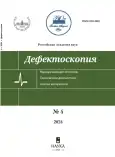No 4 (2024)
Acoustic methods
About the rational choice of the damper shape for an ultrasonic piezoelectric transducer
Abstract
The results of the study on the influence of the geometric shape of the damper on its effectiveness and the overall efficiency of the radiation-reception system are presented. One of the possible forms of the damper is considered, where it is shaped like a truncated cone, and its generatrix has an inclination angle relative to the plane of the piezoplate. A criterion for evaluating the efficiency of the damper’s operation is proposed. The study includes the results of computational-theoretical (using the finite element method) and experimental research on the influence of the incline angle of the damper’s generatrix on the signal reflected from its rear part. The inclination angle of the generatrix, at which the minimum of parasitic signals is achieved, is determined. The radiation-reception system is investigated under water loading, and a satisfactory agreement between the theoretical and experimental results is noted.
 3-15
3-15


Detection of hidden defects in composite material using the standing waves method
Abstract
As a result of the measurements carried out using the standing waves method, the hidden defects were detected inside the prosthetic feet details made of composite material. When comparing the obtained amplitude-frequency spectra of intact samples and samples with defects based on the first peaks corresponding to the first bending wave modes, it was revealed that the values of the resonant frequencies of defective samples were lower relative to the frequency values of the spectra of intact samples. That observation indicated that the material of defective products might have reduced strength characteristics. Also, when studying some samples, the presence of additional peaks was noted, which indicated the appearance of new reflection boundaries corresponding to the appearance of defects in the research samples. Maps of amplitude distributions in the studied samples were obtained. A preliminary comparison was made with the results of examining samples using the OmniScan X3 device manufactured by OLYMPUS. The results obtained indicate the presence of an increased number of reflection boundaries, as well as an increased content of bulges, which probably arise during the process of gluing products in a defective sample in comparison with a stronger one. The analysis confirms the possibility of successfully using the standing waves method as a method for detecting hidden defects in composite material.
 16-27
16-27


Electromagnetic methods
 28-37
28-37


Radiation methods
Determination of position and size of non-flaws at albedo flaw detection
Abstract
In this article the methods of determining the position and size of non-flaws in albedo flaw detection are considered. Analytical and numerical solutions of the problem of determining the location of non-flaws on the basis of known parameters of the collimation system are shown. The dependence of the location of the flaw on the parameters of the collimation system is shown. It is proposed to determine not the true size of the flaw, but its equivalent area, similar to ultrasonic flaw detection.
 38-44
38-44


Identification and classification of buckwheat grain by microfocus radiography and hyperspectral imaging methods
Abstract
Classification of buckwheat grains is important because the absence of defective grains is a guarantee of yield and quality. Buckwheat grains were randomly selected from a batch whose grains varied in quality. The identification and classification of buckwheat grains according to the degree of fulfillment was carried out by a combination of microfocus X-ray and hyperspectral image analysis and multivariate analysis techniques. Using microfocus radiography, buckwheat grains were categorized into groups according to the degree of fulfillment. Hyperspectral image of buckwheat grains in the range of 935-1720 nm was acquired using a Specim FX17 camera. Using the polygon selection function, the averaged spectra were obtained and a data matrix of grain samples was generated. The bands of the spectrum contributing most to the grading of the grain samples by degree of fulfillment were identified using the principal component analysis. The classification model of grading buckwheat grain into groups by degree of fulfillment was constructed by partial least squares discriminant analysis method. The results showed that hyperspectral image is a potential tool for rapid and accurate identification of buckwheat grains, which can be used in large-scale grain classification and grain quality determination.
 45-55
45-55


General issues of defectoscopy
Application progress and prospect of defect detection technology for timber structure members
Abstract
Timber buildings show the exquisite skills of craftsmen in China. Under the influence of nature and human activities, damage and destruction of ancient timber structures lead to the loss of China’s cultural heritage. Therefore, it is particularly important to study the existing defect detection methods of timber members and provide excellent restoration plan for the preservation of timber structures. Defects of timber structure members were found to consist mainly of cracking, decay, insect-attack, bending and pullout of tenons, etc. These defects are the main factors that affect the mechanical properties of timber members and endanger the stability of timber structures. Pilodyn, resistograph, stress wave, radar, ultrasound, X-ray, infrared spectroscopy and piezoelectric transducers are all were studies for detection methods mentioned, which belong to semi-destructive testing and non-destructive testing. In detail, the principle, development status and application cases of wood building detection technology are elaborated to demonstrate the advantages and disadvantages of these technologies in various scenarios. New and feasible detection technology should be developed, and the development direction of damage detection technology for timber structures in the future is put forward.
 56-73
56-73











